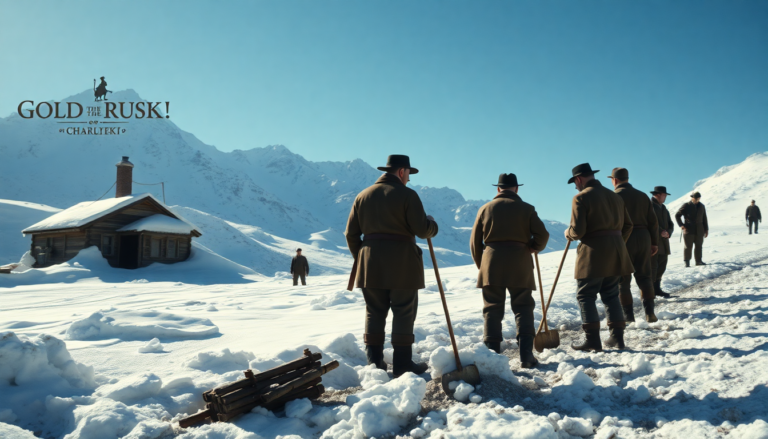Argomenti trattati
On June 26, 2025, cinephiles around the world will gather to celebrate a century of one of cinema’s most iconic masterpieces: The Gold Rush. Released on a warm summer day in 1925, this brilliant film, crafted by the legendary Charlie Chaplin, continues to resonate with audiences of all ages. As the third film in Chaplin’s illustrious career, it draws inspiration from a harrowing historical event, weaving together themes of resilience, ambition, and the enduring human spirit. But what makes this film truly timeless?
A Historical Backdrop
To appreciate the magic of The Gold Rush, we must first journey back in time. In 1846, a band of hopeful gold seekers set out for California, only to find themselves lost in the snowy peaks of the Sierra Nevada. Out of the original 160 pioneers, a mere 18 survived the ordeal; some resorted to cannibalism while others ate their shoes in a desperate bid for survival. Isn’t it fascinating how tragedy can inspire comedy? Chaplin himself recognized this paradox, illustrating the thin line that separates humor from despair. This historical backdrop serves as a poignant reminder of the lengths to which humans will go in pursuit of their dreams.
The Cinematic Journey
The Gold Rush transports us to the frigid landscapes of Alaska during the gold rush era, following the whimsical adventures of Chaplin’s beloved character, the Tramp. Set against the harsh realities of hunger, solitude, and danger, the Tramp’s relentless quest for fortune amidst the ice serves as a powerful metaphor for the indomitable human spirit. What do we do when faced with adversity? Finding refuge in a cabin with fellow prospectors, he becomes embroiled in a series of absurd and unforgettable episodes, including the iconic scene where he cooks and eats a shoe out of sheer desperation. In the midst of these trials, he finds love in Georgia, a young woman who embodies the hope of a brighter future.
Chaplin’s multifaceted role as writer, director, actor, producer, and composer for The Gold Rush speaks volumes about his artistic vision. But where were these magical scenes brought to life? While much of the film was shot in studio settings, it also features breathtaking outdoor shots that authentically capture the grim reality of the Donner Party’s tragic expedition. Can you imagine the dedication it took to bring such a vision to life?
Crafting the Illusion of Gold
The film opens with scenes of gold seekers braving the snowy mountains, filmed on location in the Sierra Nevada, which provided an authentic backdrop to the harrowing events that inspired Chaplin’s narrative. The production spanned over a year and a half, marking one of the most ambitious undertakings of Chaplin’s career. For two weeks, the crew filmed in the stunning landscapes of Truckee, California, specifically on the slopes of Mount Lincoln, now part of the Sugar Bowl Ski Resort. Here, a commemorative plaque stands as a tribute to the film’s production history. Isn’t it incredible how locations can become a part of cinematic history?
Chaplin meticulously recreated the historical image of gold seekers toiling up the Chilkoot Pass, employing 600 extras, many of whom were down-and-out individuals from Sacramento. These participants were transported by train to simulate the grueling ascent of the snow-covered slopes, embodying the slow procession of fortune hunters navigating the treacherous terrain. The level of detail is nothing short of remarkable!
While many pivotal scenes, including those inside the cabin and saloon, were filmed at Chaplin Studios in Hollywood, an intricately crafted miniature mountain range was constructed using wood, wire mesh, burlap, plaster, salt, and flour. The result was a sparkling, snow-drenched landscape that captivated countless tourists, illustrating the lengths to which Chaplin would go to create a believable and immersive world. Isn’t it fascinating to think about the artistry involved in crafting such illusions?
The Legacy of The Gold Rush
As we reflect on The Gold Rush a century later, we come to appreciate the blend of comedy and tragedy that defines Chaplin’s work. The film’s ability to evoke laughter while also addressing profound themes of human struggle and resilience is what makes it endure through time. The artistry involved in its creation, from the historical inspiration to the technical innovations, invites us to not only watch but to experience every frame. It encourages us to reflect on our own journeys, aspirations, and the moments that define our lives.
In the realm of cinema, The Gold Rush remains a testament to the power of storytelling—one that captures the essence of the human experience, transcending the bounds of time. So, as we celebrate this monumental anniversary, let us immerse ourselves in the world of Chaplin’s genius and remember that behind every film, there is a rich tapestry of history, creativity, and emotion waiting to be explored. Are you ready to rediscover this classic masterpiece?

